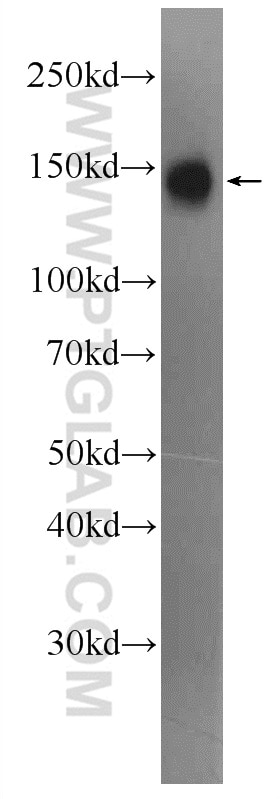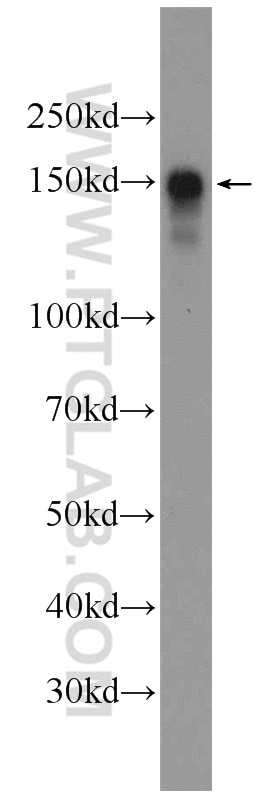Tested Applications
| Positive WB detected in | Jurkat cells, HeLa cells |
| Positive IF/ICC detected in | A549 cells, HepG2 cells |
Recommended dilution
| Application | Dilution |
|---|---|
| Western Blot (WB) | WB : 1:1000-1:4000 |
| Immunofluorescence (IF)/ICC | IF/ICC : 1:300-1:1200 |
| It is recommended that this reagent should be titrated in each testing system to obtain optimal results. | |
| Sample-dependent, Check data in validation data gallery. | |
Published Applications
| WB | See 2 publications below |
| IHC | See 1 publications below |
Product Information
24705-1-AP targets SFRS8 in WB, IHC, IF/ICC, ELISA applications and shows reactivity with human samples.
| Tested Reactivity | human |
| Cited Reactivity | human, mouse |
| Host / Isotype | Rabbit / IgG |
| Class | Polyclonal |
| Type | Antibody |
| Immunogen |
CatNo: Ag19762 Product name: Recombinant human SFRS8 protein Source: e coli.-derived, PGEX-4T Tag: GST Domain: 600-951 aa of BC136678 Sequence: LDDDSDDDEESKEGQESSSSAANTNPAVAPPCVVVEEKKPQLTQEELEAKQAKQKLEDRLAAAAREKLAQASKESKEKQLQAERKRKAALFLQTLKNPLPEAEAGKIEESPFSVEESSTTPCPLLTGGRPLPTLEVKPPDRPSSKSKDPPREEEKEKKKKKHKKRSRTRSRSPKYHSSSKSRSRSHSKAKHSLPSAYRTVRRSRSRSRSPRRRAHSPERRREERSVPTAYRVSRSPGASRKRTRSRSPHEKKKKRRSRSRTKSKARSQSVSPSKQAAPRPAAPAAHSAHSASVSPVESRGSSQERSRGVSQEKEAQISSAIVSSVQSKITQDLMAKVRAMLAASKNLQTSAS Predict reactive species |
| Full Name | splicing factor, arginine/serine-rich 8 (suppressor-of-white-apricot homolog, Drosophila) |
| Calculated Molecular Weight | 951 aa, 105 kDa |
| Observed Molecular Weight | 130-150 kDa |
| GenBank Accession Number | BC136678 |
| Gene Symbol | SFRS8 |
| Gene ID (NCBI) | 6433 |
| RRID | AB_2879682 |
| Conjugate | Unconjugated |
| Form | Liquid |
| Purification Method | Antigen affinity purification |
| UNIPROT ID | Q12872 |
| Storage Buffer | PBS with 0.02% sodium azide and 50% glycerol, pH 7.3. |
| Storage Conditions | Store at -20°C. Stable for one year after shipment. Aliquoting is unnecessary for -20oC storage. 20ul sizes contain 0.1% BSA. |
Background Information
SFRS8, also named as SFSWAP and SWAP, is splicing regulator. It regulates the splicing of fibronectin and CD45 genes. SFRS8 represses the splicing of MAPT/Tau exon 10. This antibody detects 130-150 kDa SFRS8 protein.
Protocols
| Product Specific Protocols | |
|---|---|
| IF protocol for SFRS8 antibody 24705-1-AP | Download protocol |
| WB protocol for SFRS8 antibody 24705-1-AP | Download protocol |
| Standard Protocols | |
|---|---|
| Click here to view our Standard Protocols |
Publications
| Species | Application | Title |
|---|---|---|
Clin Transl Med Splicing factor arginine/serine-rich 8 promotes multiple myeloma malignancy and bone lesion through alternative splicing of CACYBP and exosome-based cellular communication. | ||










